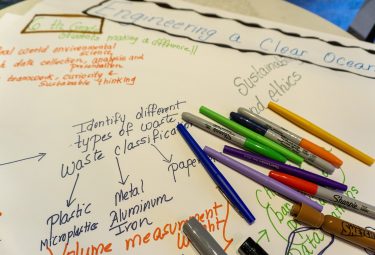Early bird rates are available for registration to the 2026 January ESIP Meeting. Register.
Increasing the Value of Earth Science Data to Improve Community Resilience
In this post, ESIP Community Fellow Zachary Robbins and members of ESIP's Community Resilience Cluster (Chair Arika Virapongse, Rupu Gupta, and Jonathan Blythe) describe the cluster's goals and activities, including the development of a problem statement.
ESIP aims for the collaborative improvement of Earth science data to better foster their use across disciplines and throughout society. Importantly, Earth science data can improve how we plan, act, and respond to a changing world at a level that engages policymakers and communities. The need has never been greater for the utilization of Earth science data by communities in order to prepare for changes in natural disaster cycles, economic uncertainties, and emerging health threats. Most Earth science data, however, remain underutilized. The ESIP Community Resilience cluster aims to help determine why that is the case and identify what we as members of the data community can do to resolve it. This post is an overview of the problem statement that our cluster has been developing, and we invite you to join us in addressing these issues.
A community resilience framework identifies how to increase a community’s capacity to adapt to a dynamic socio-ecological environment. Resilience, in engineering and ecology, describes the amount a system can be disturbed and still retain a set of defined features. Communities can expand their resilience by increasing their capabilities and resources to deal with disturbances. In the face of uncertainty, communities must take action that is not just reactive to natural and economic disasters. However, these actions vary greatly by region, social and governance structure, and circumstance.
In our cluster, we define “community” based on concepts of shared identity and engagement around common concerns. This definition does not intrinsically define a space, but rather a set of binding social interactions that occur between people. Communities often rely on decision-makers as part of their governance, and these decision-makers play a key role in how data reach communities. Decision-makers are often trusted experts within the community, though not strictly on the matter of the decision. They have a broad swath of knowledge that they draw upon to make and explain decisions. This knowledge may range from scientific to traditional knowledge, and may be formed through cultural and tacit means. How data moves from collection to decision makers is the crucial step in their utilization.
Dissemination of Earth science data is commonly conceptualized as the Data, Information, Knowledge, and Wisdom (DIKW) pathway. This pathway is made up of data providers (who collect and manage data), intermediaries (who synthesize data and communicate them), decision-makers (who interpret information and act), and those people who are impacted by the actions of decision-makers. The DIKW pathway helps to show how Earth science data are moved from collection to action as they are integrated with broader society. Oftentimes, data are gathered but exist without context. Once data are given a context within a set, relational database, and by including metadata, it becomes information. As information is collected and interpreted, it contributes toward understanding of a phenomenon, transforming it into knowledge. When this knowledge can be applied to make decisions under uncertainty, it becomes wisdom.
Throughout this pathway, we recognize three overarching challenges that prevent data from reaching a larger audience. First is the misalignment of goals and different incentive structures of scientists and decision-makers. Second is the inherent human dynamics in data. And lastly, the challenge of data accessibility and finding the right data. These challenges are described in more detail here.
The Misalignment of Goals Between Earth Science Data Providers and Decision-makers
Inherent differences in incentive structures between the Earth sciences and communities can result in the limited utility of data products. Scientists are typically driven to develop more high-level theoretical information, while aiming to reduce and uncover uncertainties in the data. As a result, research is often conducted at unactionable scales (e.g., incredibly vast or incredibly small; dealing with the distant past or the distant future). This contributes to an incentive structure that promotes the generation of information that is often largely disconnected from community resilience needs, which are often reactive, urgent, and dependent on the local context. Without making an effort to provide data and information in a way that considers the needs of community groups, data ostensibly does not exist for those groups.
Addressing this misalignment of goals requires Earth scientists to understand and incorporate the context in which community decision-makers operate. Decision-makers must often act on fixed times scales and fast turnaround, resulting in the use of incomplete datasets (or not using any data at all) to make important decisions. Preparing useful data means that the right data must be generated (i.e., aligned with the context and question of the decision-maker), and they must be formatted into products that decision-makers can use. Another challenge is that decision-makers must address inherently cross-disciplinary issues, while Earth science research often focuses on disciplinary-specific topics. The development of more transdisciplinary research around community resiliency goals would greatly improve the utility of Earth science data.
Human Dimensions and Hierarchies within Science
The scientific enterprise can include many problems that arise from the interaction of the people who conduct it and the hierarchy of structures within it. These include epistemic problems within science, the drivers of research, tribalism in scientific understanding, and limitations to the types of knowledge science can provide. Disenfranchisement of certain communities from scientific access and interpretation may increase suspicion around scientific application. This is particularly true of the Earth sciences, which often rely on small groups of people to analyze and summarize data, often in a way that can be value driven. Data ethics is also important, because sensitive data need to be protected from misuse or from being misused further down the DIKW pipeline.
Different ways that this problem is being addressed includes contributing to education and outreach, the development of trust certification systems, technological data termination, and acceptable use-licensing (i.e., copyright or other protection licensing). Educating communities on data usage, involving them in data creation, and helping them to identify trusted data are fundamental to the ability of communities to have data autonomy.
Data Accessibility
Decision-makers and communities often have difficulty assessing whether data are appropriate for the unique problems they wish to address (i.e. fit for use). Finding data that are pertinent to the problems faced in a community is dependent on data being translated in a manner that allows communities to utilize it. Earth science data are often presented in a manner that is only appropriate for a given set of end-users (usually other scientists), making the data difficult or inaccessible by decision-makers. Obstacles to accessibility stem from such issues as data formatting and presentation, and the need for high levels of computing power to access and use them.
To overcome this challenge, scientific data must be discoverable by a broader community without the domain understanding of the semantic structure. Semantic web technologies and geographic information systems may allow for greater intelligent discovery from groups seeking out data. This allows for the conceptual linking of terms to be understood in a manner that is both scientifically consistent and accessible.
Contributing to Community Resilience through Earth science requires a wide breadth of change. Fundamentally, we must realign our values within science itself, so that science provides more resources to a broader audience. We need to better understand what biases govern data generation and how data are utilized within communities. Lastly, we must improve our technological basis for data discovery, access, and certification.
View recent posters about the Community Resilience Cluster including images associated with the three challenges described above here.
If you have any feedback or are interested in linking the actions of other ESIP clusters to our work, please feel free to attend our monthly meeting on the 3rd Wednesday of every month at 1pm PT/ 4pm ET. Find more Information at http://wiki.esipfed.org/index.php/Community_Resilience.



